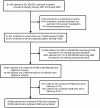Risk for hospital readmission following bariatric surgery
- PMID: 22412881
- PMCID: PMC3296721
- DOI: 10.1371/journal.pone.0032506
Risk for hospital readmission following bariatric surgery
Abstract
Background and objectives: Complications resulting in hospital readmission are important concerns for those considering bariatric surgery, yet present understanding of the risk for these events is limited to a small number of patient factors. We sought to identify demographic characteristics, concomitant morbidities, and perioperative factors associated with hospital readmission following bariatric surgery.
Methods: We report on a prospective observational study of 24,662 patients undergoing primary RYGB and 26,002 patients undergoing primary AGB at 249 and 317 Bariatric Surgery Centers of Excellence (BSCOE), respectively, in the United States from January 2007 to August 2009. Data were collected using standardized assessments of demographic factors and comorbidities, as well as longitudinal records of hospital readmissions, complications, and mortality.
Results: The readmission rate was 5.8% for RYGB and 1.2% for AGB patients 30 days after discharge. The greatest predictors for readmission following RYGB were prolonged length of stay (adjusted odds ratio [OR], 2.3; 95% confidence interval [CI], 2.0-2.7), open surgery (OR, 1.8; CI, 1.4-2.2), and pseudotumor cerebri (OR, 1.6; CI, 1.1-2.4). Prolonged length of stay (OR, 2.3; CI, 1.6-3.3), history of deep venous thrombosis or pulmonary embolism (OR, 2.1; CI, 1.3-3.3), asthma (OR, 1.5; CI, 1.1-2.1), and obstructive sleep apnea (OR, 1.5; CI, 1.1-1.9) were associated with the greatest increases in readmission risk for AGB. The 30-day mortality rate was 0.14% for RYGB and 0.02% for AGB.
Conclusion: Readmission rates are low and mortality is very rare following bariatric surgery, but risk for both is significantly higher after RYGB. Predictors of readmission were disparate for the two procedures. Results do not support excluding patients with certain comorbidities since any reductions in overall readmission rates would be very small on the absolute risk scale. Future research should evaluate the efficacy of post-surgical managed care plans for patients at higher risk for readmission and adverse events.
Conflict of interest statement
Figures




References
-
- Santry HP, Gillen DL, Lauderdale DS. Trends in bariatric surgical procedures. JAMA. 2005;294:1909–1917. - PubMed
-
- American Society for Metabolic and Bariatric Surgery, Metabolic & Bariatric Surgery Fact Sheet. Final report May 2011. Gainesville, FL: Media Press Kit; 2011. Available: http://s3.amazonaws.com/publicASMBS/MediaPressKit/MetabolicBariatricSurg.... Accessed 2011 August 25.
-
- Buchwald H, Avidor Y, Braunwald E, Jensen MD, Pories W, et al. Bariatric surgery: a systematic review and meta-analysis. JAMA. 2004;292:1724–1737. - PubMed
-
- Dorman RB, Abraham AA, Al-Refaie WB, Parsons HM, Ikramuddin S, et al. Bariatric Surgery Outcomes in the Elderly Population: An ACS NISQIP Study. J Gastrointest Surg. 2011;16:35–44. - PubMed
MeSH terms
LinkOut - more resources
Full Text Sources
Other Literature Sources
Medical

